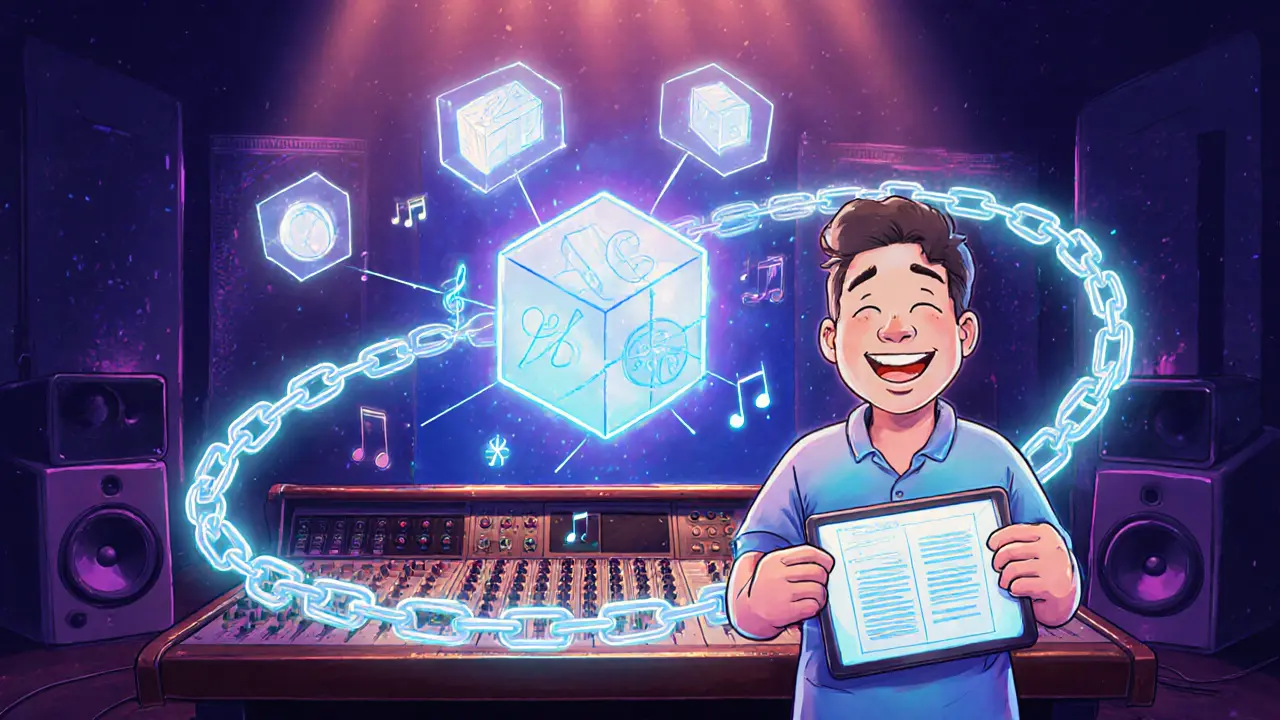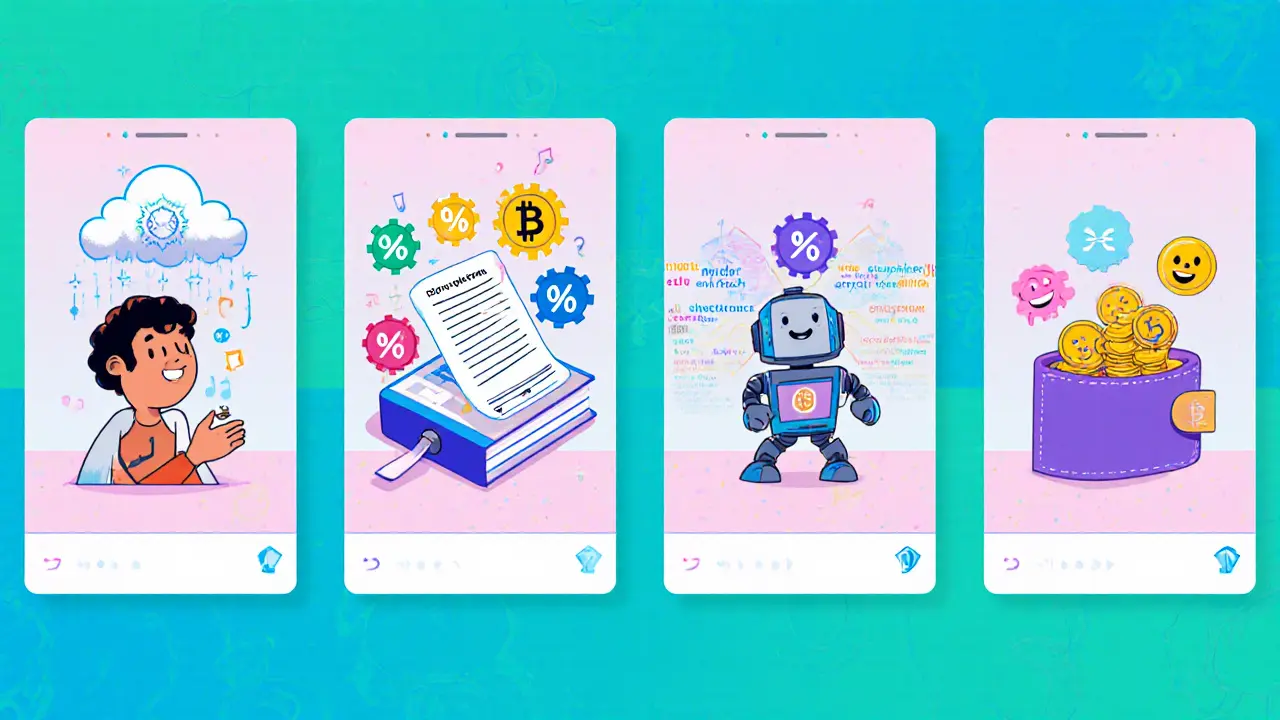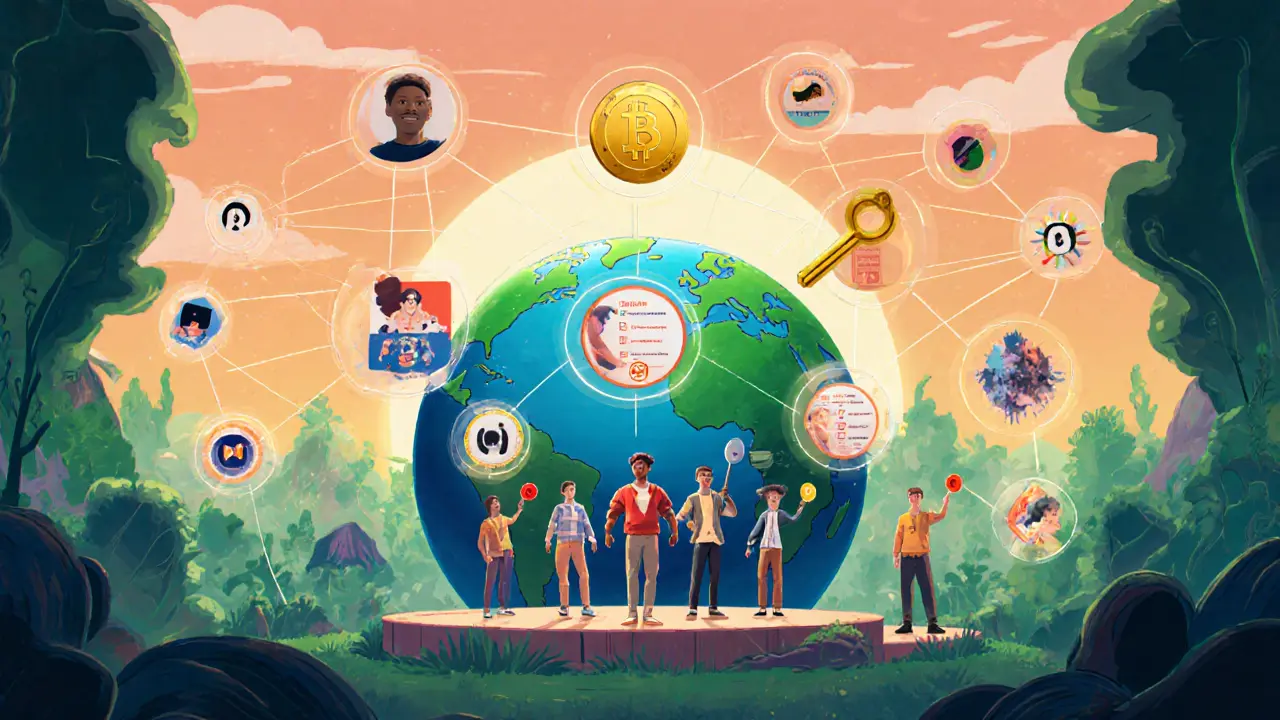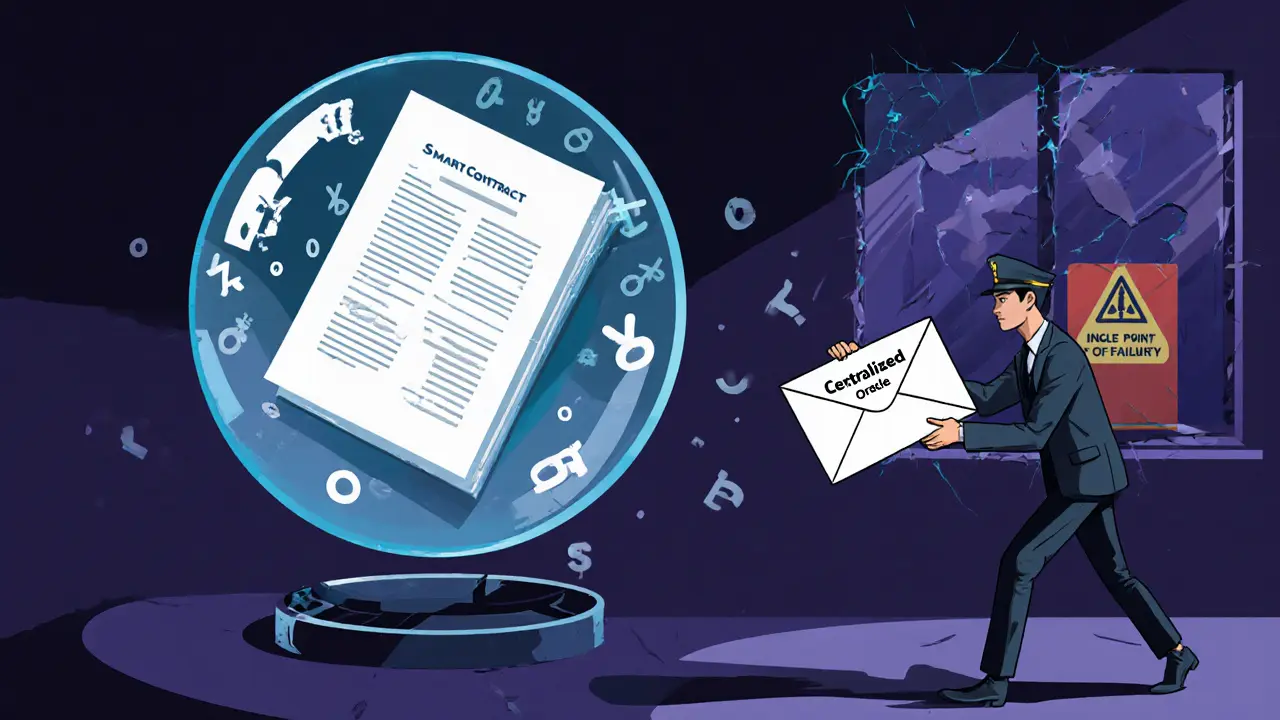
- 6 Feb 2025
- Elara Crowthorne
- 23
Blockchain Music Rights Calculator
Royalty Distribution Parameters
Blockchain Impact Analysis
Smart Contract Benefits:
- Automated royalty splits upon each stream
- Immutable ownership records
- Real-time transparency for all stakeholders
- Disintermediation of traditional middlemen
Estimated Distribution:
* This calculator demonstrates how smart contracts can automate royalty calculations and reduce delays. Actual implementation depends on blockchain infrastructure and legal frameworks.
How Blockchain Transforms Music Rights
In a traditional system, artists often wait months or years to receive their royalties due to complex intermediaries and manual processes. With blockchain, smart contracts automatically execute royalty distributions the moment a track is played, reducing payout lag from two years to seconds. Additionally, immutable ledgers ensure ownership records are accurate and tamper-proof.
Quick Takeaways
- Smart contracts automate royalty splits the moment a track is streamed.
- Immutable ledgers give artists an unchangeable record of ownership.
- NFTs create new revenue streams while preserving underlying rights.
- Real‑time payments can cut the two‑year payout lag of traditional collection societies.
- Legal and data‑entry challenges remain, but standards are emerging fast.
When it comes to protecting a song, Blockchain is a distributed ledger technology that records transactions in an immutable chain of blocks offers a new way to track ownership. The buzz isn’t just hype - blockchain music rights actually change how royalties flow, how licenses are negotiated, and how fans interact with their favorite artists.
What makes blockchain fit for music rights?
At its core, a Smart Contract is self‑executing code that runs when predefined conditions are met. In music, those conditions can be as simple as “artist A receives 5% of every stream on platform X.” Once the contract is deployed, the code enforces the split without a middleman.
Combine that with a Decentralized Ledger that stores every transaction across many nodes, making it tamper‑proof, and you get a system where every ownership change, licensing agreement, or royalty payout is permanently recorded.
How traditional rights management falls short
Before blockchain, the music value chain looked like this:
| Aspect | Traditional System | Blockchain‑Based System |
|---|---|---|
| Ownership records | Scattered across multiple societies, often outdated | Single immutable ledger, instantly updated |
| License negotiation | Manual contracts, long email threads | Automated smart contracts, real‑time verification |
| Royalty payments | Quarterly/annual, delayed up to two years | Instant payouts after each play |
| Transparency | Opaque, artists often blind to usage data | Full visibility for all participants |
| Intermediaries | Multiple layers (labels, publishers, PROs) | Disintermediated, artist‑centric |
The table underscores why many creators are eager to experiment with blockchain solutions.

Key components of a blockchain music ecosystem
1. Music Rights Registry - a catalog where each work’s metadata (title, writers, publishers) is stored as a digital fingerprint.
2. Royalty Smart Contract - defines who gets paid, how much, and when. It triggers automatically whenever a usage event (stream, download, sync) is recorded.
3. NFT Token - represents a unique edition, fan‑owned share, or even a licensing bundle. The NFT can carry embedded rights data that smart contracts read.
4. Music Streaming Platform - integrates with the blockchain via APIs, sending play counts to the ledger in near real‑time.
5. Legal Framework - local copyright statutes that recognize blockchain‑recorded ownership and provide enforcement mechanisms.
Step‑by‑step: Setting up a blockchain rights workflow
- Mint the work. The artist or label uploads the audio file to a secure storage service, generates a cryptographic hash, and writes the hash plus metadata to the rights registry.
- Deploy a royalty contract. Using a platform like Ethereum, Flow, or a purpose‑built music chain, the creator defines the payout percentages for writers, performers, producers, and any label share.
- Connect streaming partners. Platforms embed a small SDK that reports each play back to the blockchain. The SDK includes the track’s hash, user ID (anonymized), and timestamp.
- Trigger payouts. As soon as a play is logged, the smart contract calculates each stakeholder’s cut and transfers the amount in the native token or a stablecoin to the pre‑registered wallet addresses.
- Audit and dispute resolution. Because every transaction is recorded, artists can instantly verify that they were paid correctly. If a dispute arises, the immutable ledger serves as evidence in court.
This workflow can shrink the royalty cycle from months to seconds.
Real‑world pilots and what they’ve achieved
Several projects have already demonstrated the model:
- Ujo Music (built on Ethereum) let independent artists release songs as NFTs and collect royalties directly from streams.
- Vezt tokenized future royalty streams, giving fans the chance to invest in a hit before it tops the charts.
- Dot Blockchain (a Dubai‑based startup) launched a media‑chain that automatically records usage across TV, film, and music, cutting licensing paperwork by 80%.
These pilots consistently report faster payouts (often under a day) and a reduction in administrative overhead of 30‑50%.

Challenges that still need solving
Even with clear benefits, the ecosystem isn’t plug‑and‑play:
- Data entry quality. The blockchain only records what you feed it. If the initial metadata is wrong, the ledger faithfully preserves the mistake.
- Legal harmonisation. Copyright laws differ between the US, EU, and Asia. A smart contract written for one jurisdiction may not be enforceable elsewhere.
- Scalability and fees. Public chains can suffer from high gas costs during peak usage. Layer‑2 solutions and purpose‑built music chains aim to keep transaction fees below a cent per stream.
- User adoption. Artists need wallets, and many are uncomfortable handling private keys. User‑friendly custodial services are emerging to bridge this gap.
Future outlook: Where the industry could be in 2027
By 2027 we may see three major shifts:
- Standardised rights token. A global consortium could agree on a common NFT schema that encodes songwriter, publisher, and performer splits, making cross‑platform interoperability seamless.
- Hybrid royalty models. Artists might blend traditional PRO collections with blockchain payouts, capturing the best of both worlds while the legal system catches up.
- Fan‑first economies. Tokens could grant holders voting rights on setlists, exclusive remix stems, or even a share of future streaming income, deepening the artist‑fan relationship.
If these trends continue, the music value chain will look far less like a pyramid and more like a collaborative network where every participant sees exactly how value moves.
Frequently Asked Questions
What is a music rights registry on blockchain?
It is a digital catalog that stores each song’s fingerprint, ownership metadata, and any subsequent transfers on an immutable ledger. Think of it as a global, tamper‑proof spreadsheet that anyone can query.
How do smart contracts calculate royalties?
When a play event is recorded, the contract reads the pre‑defined percentages (e.g., 50% to the songwriter, 30% to the performer, 20% to the label) and automatically triggers token transfers to the corresponding wallet addresses.
Can NFTs replace traditional copyright?
NFTs represent a specific bundle of rights (like a limited‑edition remix) but they do not override existing copyright law. They sit on top of the legal framework, providing new ways to monetize and track ownership.
What happens if I upload the wrong metadata?
Because the ledger is immutable, the mistake stays until a new transaction updates the record. Most platforms include a correction mechanism that appends a new, verified entry, preserving audit trails.
Are there tax implications for receiving crypto royalties?
Yes. In most jurisdictions, crypto receipts are treated as taxable income at the fair market value on the day of receipt. Artists should consult a tax professional familiar with digital assets.


23 Comments
Reading through this, I can really feel the frustration many independent artists face with the old royalty system. The idea of instant payouts is a game‑changer, especially for those grinding on streaming platforms. It also opens up a space for more transparent collaborations between songwriters and producers. I’m hopeful that as these tools become more user‑friendly, smaller creators won’t have to rely on middlemen anymore. Ultimately, it’s about giving artists the respect and timely compensation they deserve.
THIS IS JUST A GIMMICK, NOT A REA LIST SOLUTION. BLOCKCHAIN CAN'T FIX THE INDUSTRY IF THE ARTISTS DONT GET RECOGNIZED. STOP PUMPING HYPE!
Sure, blockchain sounds shiny, but let’s not pretend it will magically solve every licensing nightmare. The legal frameworks are still lagging behind, and you can’t just bypass the intricacies of performance rights with code. Until governments recognize smart contracts as binding, we’ll still be stuck in a gray area. Also, the environmental cost of some chains is a real concern. So, while the tech is promising, it’s not a silver bullet.
The excitement is palpable, yet I can’t help but feel a twinge of doubt. Transforming rights management with blockchain is undeniably bold, but the industry’s inertia is massive. Artists could finally see their work valued in real time, but without proper education, many might get lost in the tech jargon. It’s a delicate balance between innovation and accessibility, and we need both to succeed.
Hey folks, just wanted to add a quick tip: when setting up a royalty smart contract, always double‑check the wallet addresses and percentage splits before deploying. A tiny typo can lock funds forever. Also, consider using a testnet first to simulate payouts. This can save a lot of headaches down the line.
What an exciting read! The prospect of blockchain reshaping music rights management opens a new horizon of possibilities for creators and listeners alike. First, the instantaneity of royalty distribution can dramatically improve cash flow for emerging artists who often struggle with delayed payments that can take months or even years. This immediacy also encourages more frequent collaborations, as contributors can see tangible results of their work almost in real time. Moreover, the immutable nature of a decentralized ledger ensures that ownership records are tamper‑proof, reducing disputes over who owns what and when. By having a single source of truth, legal battles become less common, saving both time and money.
In addition to speed and security, blockchain enables unprecedented transparency. Every stakeholder can audit the flow of funds, fostering trust among parties that were previously shrouded in opacity. This could also empower fans, who might gain insight into how their streams directly benefit the artists they love. The integration of NFTs adds another layer of monetization, allowing artists to sell limited‑edition releases or exclusive rights without relinquishing core ownership.
However, we must not overlook the challenges. Data entry quality remains a critical issue; garbage in, garbage out still applies. If the metadata uploaded is incorrect, the ledger will faithfully preserve that error. Therefore, robust verification processes and standardised metadata schemas become essential. Legal harmonisation across jurisdictions also poses a hurdle, as copyright laws differ significantly worldwide. Smart contracts written for one region might lack enforceability elsewhere, necessitating adaptable frameworks.
Scalability and transaction costs present further considerations. Public chains can suffer from high gas fees during peak usage, potentially making micro‑royalties uneconomical. Solutions such as layer‑2 protocols and purpose‑built music blockchains are emerging to mitigate these costs, but widespread adoption will require continued innovation.
Lastly, user adoption hinges on accessibility. Many artists are unfamiliar with managing private keys and wallets, which may deter them from embracing the technology. User‑friendly custodial services and intuitive interfaces are vital to bridge this gap. In summary, while blockchain offers a compelling vision for a more equitable and efficient music ecosystem, its success will depend on addressing data integrity, legal compatibility, scalability, and usability challenges.
Nice overview.
Great breakdown! I love how the piece points out both the bright side and the pitfalls. It’s refreshing to see a balanced view instead of just hype. Keep the info coming.
Listen, the whole blockchain‑music narrative is a distraction from the real agenda. The industry elites want to push a “decentralized” model only because it lets them shift control to obscure crypto‑fiefdoms while the average musician gets lost in code. Think about who profits from these smart contracts-usually venture‑backed platforms that take a cut, not the creators. And the environmental footprint of proof‑of‑work chains is a silent killer, yet it’s glossed over in every press release. In the end, it’s just a shiny veneer over the same old power structures.
Interesting points. It’ll be cool to see how this plays out in practice.
Esteemed colleagues, the integration of immutable ledgers into intellectual property regimes warrants rigorous scholarly examination. The confluence of cryptographic assurances and fiduciary obligations may, in principle, engender a paradigm shift in remuneration fairness. One must, however, assess the epistemic underpinnings of existing legal doctrines to ensure harmonious coexistence with emergent decentralized mechanisms.
The idea of instant royalties is downright electrifying! Imagine composing a track and seeing the payout hit your account within seconds-pure adrenaline. This could revolutionize the creative process, letting artists focus on art instead of chasing paperwork.
Sure, blockchain sounds cool, but let’s not pretend it solves everything. I’d love to see real‑world data before buying into the hype.
I’ve seen a lot of “solutions” come and go, and this one feels like another fad. The technology is impressive, but without solid industry backing, it won’t get far. Just another buzzword for now.
Oh great, another blockchain project promising to fix everything. Because code always knows best, right? 🙄
i think its a good step forward but im also worried about how complex it might be for new artists. a little more user friendly approach would be nice.
From a technical perspective, it is essential to enforce rigorous standards for metadata validation to avoid the “garbage‑in, garbage‑out” problem. I recommend implementing a multi‑layer verification pipeline that includes both automated hash checks and manual audits by trusted registrars. This approach will preserve the integrity of the rights registry while maintaining scalability.
It’s simple: if it’s on the blockchain, it’s real. No more secret deals.
Cool tech, but let’s keep it simple for the everyday musician.
From a systems architecture stance, the integration of streaming APIs with on‑chain event listeners must be optimized for throughput to prevent bottlenecks. Leveraging asynchronous processing queues can help maintain real‑time payout capabilities without overwhelming the blockchain network.
One might assert, with a modicum of hubris, that blockchain will inevitably supplant all archaic mechanisms; yet, paradoxically, it may also engender novel forms of centralization-an oxymoronic destiny, perhaps?
Seriously? Another “revolutionary” tech buzzword. I’ve seen this hype before and it always fizzles. Let’s see the real impact before we all start chanting.
Interesting read-definitely a step forward; however, the industry must address the practical challenges before widespread adoption can occur.